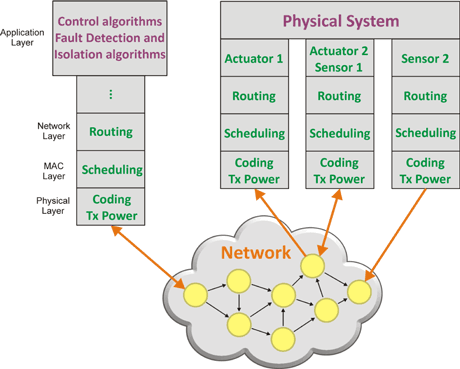by Maria Domenica Di Benedetto and Alessandro D’Innocenzo
In the context of the EU FP7 Network of Excellence HYCON2, DEWS, a Centre of Excellence established at the University of L’Aquila in 2002, is developing a unifying mathematical framework that takes into account the joint dynamics of physical systems, control algorithms and wireless communication protocols. In addition, the framework provides an enabling technology for Cyber-Physical System (CPS) design and implementation.
The growing relevance of Cyber-Physical Systems (CPS) is due in part to the development of technologies that are essential for their effective deployment, namely: embedded systems and wireless communication networks. In particular, Wireless Sensor and actuator Networks (WSN) have greatly facilitated and enhanced the automated, remote and intelligent monitoring and control of a large variety of physical systems. These networks consist of many tiny, inexpensive and low-power devices, each incorporating sensing, actuation, processing, and wireless communication capabilities. These devices are now used in a number of application domains from industrial and building automation, to environmental, wildlife, and health monitoring, and disaster relief management. In these applications, computation and communication devices represent the enabling technology for WSN, while some of the most advanced WSN applications currently available are used for control tasks. Wireless Control Networks (WCN) are WSN applied to control.
The opportunities offered by WCN, and the increasing computing power of control nodes, are accompanied by some tough challenges. To advance the state-of-the-art in modelling, analysis and design of WCNs, classical control problems have to take into account the joint effect of Control, Computation and wireless Communication, evidencing the need to solve new theoretical and implementation problems. Despite some initial fundamental scientific achievements, the convergence of the “3Cs” has not yet had a significant impact on society and industry. In some cases, methodologies have been derived for general models, but their computational complexity results are intractable, i.e. they require the solution of NP-hard or even undecidable problems. In other cases, methodologies have been developed with an affordable computational complexity, but for simplified models that neglect the most relevant issues arising in real implementations - e.g., critical non-idealities, communication protocol dynamics and constraints, limited resources - rendering them practically useless. In general, scientific research on WCNs models the network non-idealities as aggregated network performance variables or disturbances, neglecting the dynamics introduced by the communication protocols.
In the context of the EU FP7 NoE HYCON2, multidisciplinary research at the DEWS Centre of Excellence, University of L’Aquila, Italy, is developing a unifying mathematical framework that takes into account the joint dynamics of physical systems and communication protocols (see Figure 1). By formally quantifying the interactions within the heterogeneous environment typical of WCN, we expect that powerful formal methods and tools, developed over decades by different (and often disconnected) scientific communities, can now be combined to solve problems arising in a WCN.

Figure 1: Control loop over wireless networking protocols.
In collaboration with Prof. George J. Pappas, University of Pennsylvania, USA, and Prof. Karl H. Johansson, Royal Institute of Technology, Sweden, we proposed to model as a Switching Linear System the joint dynamics of a physical system, an embedded controller and of the MAC (scheduling) and Network (routing) ISO/OSI layers of a time-triggered communication protocol over a shared multi-hop communication network [1]. In particular, our framework makes it possible to model recently developed wireless industrial control protocols such as WirelessHART and ISA-100.
On the basis of this mathematical framework, we considered WCNs subject to failures and/or malicious attacks in the communication nodes [2]: we addressed and solved the problem of designing a set of controllers and communication protocol parameters, making it possible to detect and isolate failures on-the-fly and consequently apply an appropriate controller to stabilize the closed-loop system. We leveraged both algebraic and graph theoretic methods to derive necessary and sufficient conditions both on the physical system (i.e., its dynamics) and on the communication protocol (i.e., on topology, scheduling, routing and network coding) that guarantee stabilizability and allow failures to be detected and isolated.
In collaboration with Prof. Raphaël Jungers, Université Catholique de Louvain, Belgium, we recently began to study the necessary and sufficient conditions for stabilizability for a WCN switching linear model. Our goal has been to leverage the particular algebraic structure induced by the networking communication protocol in order to improve theoretical understanding of the dynamics at stake in these systems. This has enabled us to design tailored controllers whose performances are better than for classical switching systems. We have also tried to distinguish situations where exact algebraic methods are still applicable from situations where the time-varying delays make the system hard to control with exact methods, obliging the researcher to resort to conservative Lyapunov-like methods.
Future activities involve the extension of our unifying mathematical framework to accurately model all the ISO/OSI layers of the communication protocols for WCNs, as well as the development of novel control methodologies and algorithms for this framework.
Links:
http://dews.univaq.it/
http://www.hycon2.eu/
http://www.hartcomm.org/protocol/ wihart/wireless_technology.html
http://www.isa.org/isa100
References:
[1] R. Alur, A. D'Innocenzo et al.: “Compositional Modeling and Analysis of Multi-Hop Control Networks”, IEEE TAC, Special Issue on WSN, 56(10):2345-2357, 2011.
[2] A. D'Innocenzo, M.D. Di Benedetto, E. Serra: “Fault Tolerant Control of Multi-Hop Control Networks” IEEE TAC, 58(6):1377-1389, 2013.
[3] R.M. Jungers, A. D'Innocenzo, M.D. Di Benedetto: “Feedback stabilization of dynamical systems with switched delays”, 51st IEEE CDC, pp. 1325-1330, 2012.
Please contact:
Alessandro D’Innocenzo
University of Aquila, Italy
E-mail:











